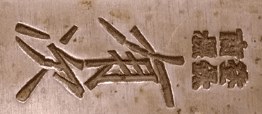Aritsugu on:
[Wikipedia]
[Google]
[Amazon]

 Aritsugu is a Japanese
Aritsugu is a Japanese
Nishiki Market - Aritsugu
{{knives Companies established in the 1560s Japanese brands Kitchen knife brands Knife manufacturing companies Manufacturing companies of Japan

 Aritsugu is a Japanese
Aritsugu is a Japanese knife
A knife ( : knives; from Old Norse 'knife, dirk') is a tool or weapon with a cutting edge or blade, usually attached to a handle or hilt. One of the earliest tools used by humanity, knives appeared at least 2.5 million years ago, as evidenced ...
and cooking utensil
A kitchen utensil is a small hand held tool used for food preparation. Common kitchen tasks include cutting food items to size, heating food on an open fire or on a stove, baking, grinding, mixing, blending, and measuring; different utensils a ...
producer and store, founded by Fujiwara Aritsugu in 1560. It is one of the oldest knifemakers in Japan.
Aritsugu was involved in the production of swords
A sword is a cutting and/or thrusting weapon.
Sword, Swords, or The Sword may also refer to:
Places
* Swords, Dublin, a large suburban town in the Irish capital
* Swords, Georgia, a community in the United States
* Sword Beach, code name for ...
and was appointed a supplier for the Imperial House of Japan
The , also referred to as the Imperial Family or the House of Yamato, comprises those members of the extended family of the reigning Emperor of Japan who undertake official and public duties. Under the present Constitution of Japan, the Emperor i ...
, before the requirement for new blades diminished due to a more peaceful era emerging through the influence of the Tokugawa shogunate
The Tokugawa shogunate (, Japanese 徳川幕府 ''Tokugawa bakufu''), also known as the , was the military government of Japan during the Edo period from 1603 to 1868. Nussbaum, Louis-Frédéric. (2005)"''Tokugawa-jidai''"in ''Japan Encyclopedia ...
during the Edo period
The or is the period between 1603 and 1867 in the history of Japan, when Japan was under the rule of the Tokugawa shogunate and the country's 300 regional '' daimyo''. Emerging from the chaos of the Sengoku period, the Edo period was characteriz ...
in the 17th and 18th centuries. During this period Aritsugu switched its primary production from swords to the pointed knives that were used to carve statues of Buddha. In the late 19th century Meiji period
The is an era of Japanese history that extended from October 23, 1868 to July 30, 1912.
The Meiji era was the first half of the Empire of Japan, when the Japanese people moved from being an isolated feudal society at risk of colonization ...
, there was strong growth in demand for kitchen knives and cooking utensils developing in Japan because of stable government and improved living conditions. Aritsugu used its experience in blade production to focus on this emerging market.
The current proprietor of Aritsugu is Shinichiro Terakubo, who took over from his father in 1956 when Shinichiro was 17 years of age. He is the 18th generation to be involved in the running of the store since its inception. Shinichiro teaches cooking, knife sharpening and use classes through the store.
The main store has been located at the Nishiki Market
is a marketplace in downtown Kyoto, located on the east end of Nishikikōji Street, one block north and parallel to and west of . Rich with history and tradition, the market is renowned as the place to obtain many of Kyoto's famous foods and ...
in Kyoto
Kyoto (; Japanese: , ''Kyōto'' ), officially , is the capital city of Kyoto Prefecture in Japan. Located in the Kansai region on the island of Honshu, Kyoto forms a part of the Keihanshin metropolitan area along with Osaka and Kobe. , the ci ...
since it moved in 1781 from Sakaimachi Street, where the shop was located for almost 200 years and where the company's offices are still based.
References
External links
Nishiki Market - Aritsugu
{{knives Companies established in the 1560s Japanese brands Kitchen knife brands Knife manufacturing companies Manufacturing companies of Japan